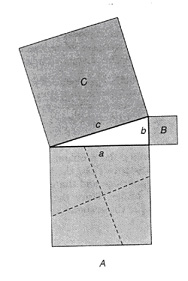| The Investigation poses questions to generate interest in various mathematical topics from the text and encourages students to formulate and investigate their own conjectures. One use of the investigations is for term papers in which students report on their
conjectures and the patterns they find.
Click on the Read Me file below to open the investigation in a Word file:
 Read Me - Pythagorean Theorem Instructions (Word Format)
(59.0K) Read Me - Pythagorean Theorem Instructions (Word Format)
(59.0K)
Laboratory Investigation 6.4Pythagorean Theorem
The Pythagorean theorem can be illustrated visually in several ways. One such illustration is shown by the following figure. Square A is divided into four regions by two dashed lines that pass through its center. One dashed line is parallel to the left edge of square C, and the other dashed line is parallel to the lower edge of square C. If these four regions and square B are traced and cut out, they can be arranged to cover square C. Try it!
 <a onClick="window.open('/olcweb/cgi/pluginpop.cgi?it=jpg::::/sites/dl/free/0072533072/78543/LI_6_4.jpg','popWin', 'width=NaN,height=NaN,resizable,scrollbars');" href="#"><img valign="absmiddle" height="16" width="16" border="0" src="/olcweb/styles/shared/linkicons/image.gif"> (26.0K)</a> <a onClick="window.open('/olcweb/cgi/pluginpop.cgi?it=jpg::::/sites/dl/free/0072533072/78543/LI_6_4.jpg','popWin', 'width=NaN,height=NaN,resizable,scrollbars');" href="#"><img valign="absmiddle" height="16" width="16" border="0" src="/olcweb/styles/shared/linkicons/image.gif"> (26.0K)</a>- Draw a right triangle with legs of length 1 inch and 2 inches and a square on each of its sides. (Right angles can be drawn by using the corner of a file card.) Subdivide the larger of the squares on the legs into four regions as described in the figure above. Show how these four regions and the square on the other leg can be arranged to exactly cover the square on the hypotenuse.
- Suppose the smaller of the squares on the legs of a right triangle is subdivided into four regions as described above. Can these regions and the square on the other leg be arranged to cover the square on the hypotenuse?
|

